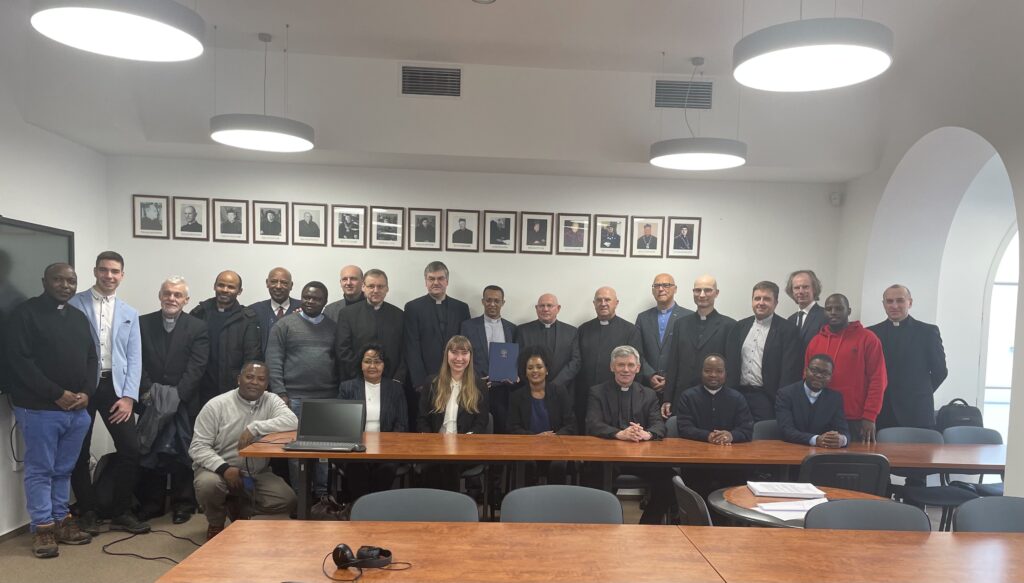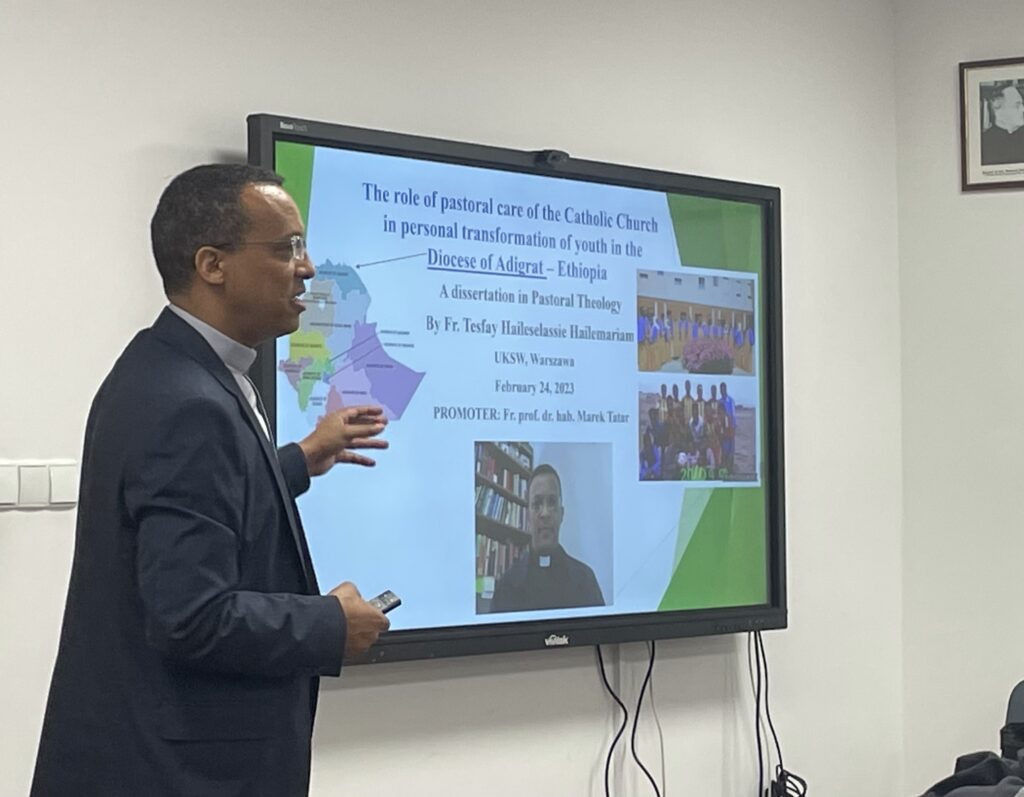A friend of the Institute of Schuman Thought Father Tesfay from Ethiopia defended his doctorate. Father Tesfaye studied doctoral studies in Pastoral Theology at the Cardinal Stefan Wyszynski University in Warsaw from 2017 to 2022. He wrote the thesis: The role of pastoral care of the Catholic Church in personal transformation of youth in the Diocese of Adigrat – Ethiopia. Father Tesfay took part in many initiatives organized by the Institute of Schuman Thought: the Chaplet of Divine Mercy, the Holy Mass on the 13th in the Warsaw Cathedral, Christmas Eve Without Borders and Easter Without Borders. We express our great congratulations and appreciation. We wish Father Tesfay many God’s blessings in youth ministry in Ethiopia.

SUMMARY OF THE DOCTORAL DISSERTATION
INTRODUCTION
The young people of the Adigrat Diocese are in need of special attention from all concerned, particularly from the Catholic Church of the Adigrat Diocese and the youth of the Ethiopian Catholic Church in general. Adigrat Diocese is one of the oldest Eparchy in the country, located in the Tigray region, northern Ethiopia. The most excellent resource any society can have is its human resources. Ethiopia is endowed with this human resource in abundance. The youth in Ethiopia constitute the majority of this human endowment and should not be taken for granted if we are to achieve the security of the society and sustainability of the Church. Disciplined young people are the safety and strength of the community and are the life and hope of the Church. The unethical and immorality are spreading highly and becoming a high level of insecurity and threat to lives. The research, however, has clearly shown that the Church has a vital role in the contemporary world to shape its new policies and direction toward youth. The Lord Jesus Christ, the head of the Church, has sufficiently equipped the Church for evangelizing, calling and forming people to the path of moral, spiritual, and intellectual integrity. Therefore, the Church cannot afford to ignore the problems facing the youths in Ethiopia. Youth pastoral ministry has a minimal lasting impact on youth in Ethiopia. If the Catholic Church wants to see the success of youth and the Church’s survival, it is essential to rethink youth pastoral ministry. Suppose the Catholic Church wants to see its children have a lasting faith. In that case, it is crucial to renew its approach toward youth in pastoral ministry in Ethiopia, especially in the Adigrat Diocese. This work is divided into five main Chapters.
RESEARCH QUESTIONS
This thesis would like to explore why the personal transformation of youth is needed. How are society’s social values disappearing, and how is it affecting the lives of the young people in the Diocese of Adigrat? How is the religious teaching at home and parishes going on? How can the Catholic Church’s pastoral care contribute to the youth’s spiritual, intellectual, moral, and social growth?
STATEMENT OF THE PROBLEM
Ethiopia’s youth face overwhelming problems that often hinder their contribution to the Church and the nation’s development. These are assumed to result from a catalog of closely related factors. Some of the supposed factors include the way of bringing them up, poverty, corrupted leaders, unemployment, lack of vocational training and skills, peer group influences, lack of basic facilities, continuing spread of exploitation and oppression of people that is rooted in racism and class domination; and lack of humanitarian and societal welfare. From time to time, the nation has witnessed crises in every aspect of life: education, health, social and political development. Because lousy leadership, corruption, political instability, and poor economic management have been society’s misery, this has created a lack of direction for the youth. Everywhere, there is an insatiable lust to get rich quickly using unprincipled means, including fraud, cheating, or migrating illegally. And the media is replete with ideas contrary to the norms expected in a moral society with their constant promotion of immorality and hatred.
To be humanity’s future, the youth need to have hope at the present . This is why the Catholic bishops in Ethiopia note, “It is of no use to declare rhetorically that the youth are the hope for tomorrow if they do not have much hope in the present” . Hence, any society and Church that allows a good percentage of its youths to be misdirected or neglected, to ignore the social values and the teaching of the Church, risks the future’s cultural viability, potentiality, and survival of society and the Church. Against these background problems, this study explored the role of pastoral care in the transformation of youth in the Diocese of Adigrat.

OBJECTIVES OF THE STUDY
The specific objectives of this research are:
1. To discover the meaning and concept of youth
2. To investigate and establish the social and cultural background of moral values and the Biblical perspective of the growth in faith
3. To investigate and examine the current challenges of youth ministries
4. To suggest a way of possible solutions to the problems of youth ministries
5. To educate the Christian youth on the appropriate Christian ethics to be followed in society.
SIGNIFICANCE OF THE STUDY
This research is very significant because youths are the future of the Church and the state. It will assist youth ministers, whether clergy or laity and the society at large with adequate information that can readily be used in instructing and guiding the youth in the Church and society. The ignorance of the Church’s teachings and social values of the community by the young people and the changing lifestyles of youths are affecting the Church and society. Thus, the researcher aims to show the root cause, the implication, and the appropriate way of solving youth transformation in the Diocese of Adigrat so that Church, parents, and youth will benefit from the research findings. This work will be a good foundation and resource for all who intend to conduct further research on this topic or related topics in the future.
METHODOLOGY
When writing this thesis, the researcher will follow the see–judge–act method commonly known as the pastoral circle. The thesis will try to show that it has seen a problem through the facts that the youth of the Adigrat Diocese need a new pastoral care approach. Having seen this problem, the thesis will evaluate and show how the YM can contribute to the holistic growth of the young people in the diocese in its work of pastoral ministry. Lastly, on the level of act, the thesis will propose the perspectives for a more effective youth ministry that the diocese has to follow to the success of young people’s lives in the Diocese of Adigrat.
In this research, we shall use an interdisciplinary approach. This is one of the methodological proposals for research projects under pastoral theology . An interdisciplinary approach to research or education involves integrating knowledge from two or more academic disciplines into one activity . The historical, analytical, and qualitative methods are also applied. The employment of the historical method is essential for looking at the role of pastoral care in multidimensional youth formation from the perspective of the situation on the ground. Various sources are examined and analyzed using this method to draw applicable conclusions about the personal transformation of youth. The analytical approach is employed in the examination of numerous sources and materials. In every instance, a text is divided into individual fragments to assist in understanding each part and seeing how it works. The qualitative method is adopted, which collates and analyses data from existing literature relevant to the study. It relies on existing published literature, advances existing knowledge, suggests conclusions based on the current literature, and forms a synergy of ideas while pointing out gaps. This method focuses on computing and explaining specific phenomena and presenting the meaning of concepts, which serve as an aid for the researcher to come up with facts and figures that constitute the evidence of the study.
The work will employ library and online research. These will range from the Bible to encyclopedias, books, journals, magazines, Bishops’ letters, and various official documents of the Church, as will be acknowledged in the bibliography.
STRUCTURE OF THE WORK
This work will be divided into five main Chapters. Each of the chapters is further divided into titles and subtitles. The whole work begins with a general introduction and ends with recommendations and general Conclusion. Chapter One will present Ethiopia’s general socio-economic scene, religion, and the etymological meaning of youth; Chapter Two will discuss youth formation and its components; Chapter Three will investigate the growth in faith in the light of the Scripture and Tradition of Christianity; Chapter Four will analyze the contemporary challenges of youth in the Diocese of Adigrat, and Chapter Five will propose perspectives for more effective youth pastoral ministry.
Chapter one, Ethiopia’s general socio-economic scene, religion, and the etymological meaning of youth, (pp. 18-60)
Chapter one, addressed significant and essential historical, cultural, and religious backgrounds. The chapter explored the etymological meaning and concept of youth. Ethiopia is a country of diverse cultures, ethnic, and languages. The study shows the beauty of diversity and, at the same time, the challenges that are there. In the Diocese of Adigrat, the people have valuable cultural values. They believe in justice, security, and equality. For these, the study revealed that the first Hijra, or migrants of Islam to Ethiopia’s Tigray, are a great testimony. Ethiopians passed and still struggling in political and economic reform, which highly affected young people’s lives. The study revealed that St. Justin de Jacobis (1800-1860), the first canonized missionary of Africa, re-established the Catholic communities in Tigray, where the Adigrat Diocese is, and today’s Eritrea, and opened the gate to the other parts of Ethiopia. However, even though no one doubts its leadership role in the country, the Catholic Church does not grow up according to its age. The Ethiopian Catholic Church adopts two Rites: Geez and Latin Rites, which is a beauty and, at the same time, a challenge.
It has discussed the concept and meaning of youth and youth as the stage of self-discovery. The study critically investigated that the period of youth is when a person is open to all kinds of influences and experiences several challenges, which determines a person’s future life for good or bad. It also vividly evaluated the cognitive, moral, faith, and vocational developments as primary necessities in youth ministries that need attention for the youth transformation in the Diocese of Adigrat. It outlined that youth is not only a stage of the period but also a state of mind and youth is the precious stage and unique treasure of life. The work also presented the contemporary implications of pastoral ministry with youth that society presents young people with difficulties. It presented helpful perspectives to understand young people.
Chapter two, Youth formation and its components, (pp. 61-120)
Chapter two articulated youth formation and its components that help youth’s ethics and spiritual growth. According to this study, families must be role models in Christian living, service, and respecting social values. The efficacy of the Word of God, love, prayer, education, and perseverance are the essential values of family. Only then will their children be distinct, distinguished shining lights to their generations. The family institution is a determinant institution of the youth’s psychosocial and spiritual formation. Young people that learn social knowledge and cultural values from their parents advance and develop in society. The Catholic Church must be ready to intervene and accompany young people in their journey of daily lives whenever the welfare of an individual or a particular group is adversely affected by social, economic, or political policies and physical occurrences.
Chapter three, growing in faith in light of the Scripture and Tradition of Christianity, (pp. 121-175)
Chapter three evaluates the themes that relate to the relationship between persons and God. The progress of faith depends on the knowledge and understanding of the Scripture, the Tradition of the Catholic Church and the practical life lived, and the specific goal of going out as the disciple of Jesus Christ in the service of each other. The research has shown that God places a high value on youth in the Bible. There are many examples of how youth can share in the creator’s activity and make a difference in their generations. God uses youth to share His truth. The researcher presented some Biblical themes that demonstrate how the youth should be formed and the goals of young people’s growth in faith. Youth who started well and stayed committed to their God and the godly inheritance never permitted their magnificence position to make them lose sight of their faith. Youth who stand true to the salvation they received to the extent that they are willing to follow Christ even to the point of crucifixion unwaveringly. The Holy Bible and the Tradition of the Catholic Church have everything the youth need for past, present, and future lives to live. As young people grow physically, it is also important that they advance spiritually and intellectually in their faith. Therefore, the study underlines the importance of further instructions needed through pastoral ministries. It also emphasizes the necessity of giving directions for teaching about equality, dignity, freedom, and the Christian identity. In accomplishing these, it is essential to study young people’s present situation and their faith life.
Chapter four, The contemporary challenges of young people, (pp. 176-207)
Chapter four recalled the challenges that affected the Christians in the Diocese of Adigrat. The challenges mentioned are becoming a spiritual danger for Catholics today, particularly young people. Social media plays a role in spreading various kinds of information and becomes means to the other challenges affecting the lives of Christians. Pieces of information either strengthen the relationship between the communities or disintegrate them. Thus, information should always be correct, accurate, and complete because it helps build up and spread Christian values among communities and enables them to defend the truth. If social media is used correctly, it can be a means of spiritual growth, excellent service to all people, in solving other challenges, and a path for evangelization according to the mission of the Church and the plan of God through making Jesus Christ the center of the young generation’s daily life. The young people are living in a world where secularism is spreading, religious pluralism is in progress from time to time, unemployment is increasing, and poverty is blossoming. Politicians are not able to bring peace to their citizens, and as a consequence, displacement and migration are affecting the lives of the youth. There are great opportunities and possibilities where most of the youngest population is. The Church can play a great role in helping young people to see their opportunities and possibilities through discovering their talents.

Chapter five, perspectives for more effective youth pastoral ministry, (pp. 208-258)
Chapter five presented the possible perspectives to adopt for the effective result in youth pastoral ministries among young people. The recent finding in this research shows that the lifestyle of young people creates multidimensional problems, including the physical, social, mental, spiritual, intellectual, and psychological dimensions of young people’s being. The aim of presenting possible perspectives was to improve the understanding of this research at a glance.
This chapter tried to show essential ideas or proposals for effective action to be taken locally in the youth pastoral ministry of the diocese. Currently, the young generations live in a world obsessed with various kinds of crises, and yet some chances can give hope, and it is important to build up those opportunities. This cannot become at one point, but it is a development process through guidance and by showing direction. It is essential to focus on the practical actions that can improve the lives of the young generations. The Word of God and the Sacraments are the pillars to provide the richness of the Person of Jesus Christ through various kinds of movements and organize ongoing formations and opportunities where the young generation can discover their talents. Among different models for youth ministry, three models for evangelizing young people today are identified: The Traditional Deductive Model (TDM), Modern Deductive Model (MDM), and the Transforming Inductive Model (TIM).
CONCLUSION
In conclusion, the results of this work confirm that the Church and the government must not leave the ethical and social issues of youth transformation and its implications in the hands of individuals and parents to handle alone. Many things have been messed up at present due to the government not working with the Church on ethical, social, and human development issues. Therefore, the Church and the state should work together to deal with the challenges that affect both. Church and state leaders should note that what affects one also affects the other.

